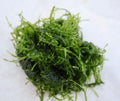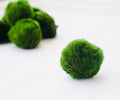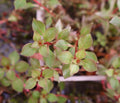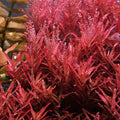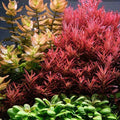Things Needed to Your Aquascaping Journey
To set up an aquascape that works, you need to think carefully about what tools you need and how to set it up. In this guide, we'll talk about the tools you'll need for aquascaping, such as substrate, lights, CO2 supplements, and fertilizers. In this post, we'll show you how to set up your tank so that it has the right conditions for plants to grow well and has a beautiful aquascape.
Things Needed to Set Up Your Tank
Substrate
It's important for the health and growth of your water plants to choose the right substrate. Choose materials that are rich in nutrients and made for tanks with plants. These soils give the roots of plants the nutrients they need to grow well. Some examples are nutrient-rich dirt, plant substrates made just for that plant, or a mix of both.
Light
Aquarium plants need the right amount of sunshine for photosynthesis and their general health. Choose light sources that give your plants the right amount and type of light for their needs. LED lights are famous because they use less energy, can be dimmed, and can have different color temperatures. Aim for 8 to 10 hours of lighting per day to make it look like natural sunlight.
CO2 Supplementation
Adding carbon dioxide (CO2) to the air is a good way to help plants grow quickly. It's very important in high-tech aquariums with plants. You could use a CO2 injection device to give your plants a steady flow of carbon dioxide. This will help them grow, change color, and be healthier overall. You can add more CO2 by using either compressed CO2 gas or liquid carbon dioxide.
Fertilizers
In order to grow well, aquatic plants need certain nutrients. By adding fertilizers, you make sure they get all the nutrients they need for good growth. Choose a liquid fertilizer that has a healthy mix of macronutrients (nitrogen, phosphorus, and potassium) and micronutrients (iron, manganese, etc.). Giving your plants the right amount of fertilizer on a regular basis will help them grow well and prevent nutrition shortages.
Putting the fish tank together:
Before you put the sand in the tank, you should rinse it and get it ready. Rinse it well under running water to get rid of any dirt or dust.
On the bottom of the tank, put a layer of sand. What you want to grow will determine how thick the base layer needs to be. A depth of 2 to 3 inches will give the roots plenty of room to grow.
Put the lighting system on top of the tank in a safe way. Change the height and placement of the lights to make sure the area is evenly lit and to get rid of shadows.
Follow the directions from the maker to hook up and set up the CO2 injection device. Keep the CO2 levels where they should be for plants to grow well, which is usually between 20 and 30 parts per million (ppm).
Start a plan for fertilizing your plants based on what they need. Follow the amount instructions given by the maker and keep an eye on how your plants grow and look so you can make any necessary changes.
Know the Principles
Know the key design ideas like balance, focus points, and depth, and try out different techniques like planting in the center, middle ground, and background. By using these ideas and methods, you can make your tank look like a beautiful underwater scene.
Balance
Creating a peaceful aquascape is impossible without balance. There are two kinds of balance: those that are equal and those that are not. Symmetrical balance means putting things in the aquarium in the same way on both sides, while asymmetrical balance gives the tank a more natural and interesting look. Balance the aquascape by placing plants, rocks, and decorations in a way that takes their size, shape, and visible weight into account.
Focal Points
Focal points draw attention to the aquascape and make it more interesting. Choose something that stands out, like a unique plant, a piece of driftwood, or an interesting rock creation, to be the main point. Using the rule of thirds, put it off-center to make it stand out and give it a feeling of depth.
Depth
To make an aquascape look interesting, you need to give it a feeling of depth. One way to do this is to use the method of planting in the center, middle ground, and background. Use low-growing plants or types that spread out to create a sense of closeness in the center. Put medium-sized plants in the middle ground and arrange them to give the scene depth and a smooth shift between the center and background. Put bigger plants, rocks, and other decorations in the background to give the impression of distance.
Rule of Thirds
The rule of thirds is a guideline for how to put things together that can be used in aquascaping. Think of two horizontal and vertical lines that are the same distance apart and divide the tank into nine equal parts. To make a design that looks good, put the main points or most important parts at the intersections or along the lines.
Contrasting colors and patterns
Use different colors and patterns to add visual interest and make an aquascape that moves. Mix and match plants with different leaf shapes, colors, and textures to make an arrangement that is interesting to look at. Use the color wheel as a guide to choosing colors that go well together or that stand out from each other for a lively and well-balanced arrangement.
Negative Space
In an aquascape, empty space, or "negative space," is just as important as the other parts. Let parts of the aquarium be empty or lightly grown to give the fish room to move around and draw attention to the aquarium's main features. This empty room gives the whole design a sense of balance and simplicity.
By knowing and using design principles like balance, focus points, and depth, and using methods like planting in the foreground, middleground, and background, you can make an aquascape that is beautiful and interesting to look at. Try out different styles, textures, and color choices until you find one that you like. Remember that aquascaping is an artistic process, so give yourself the freedom to discover and make your own underwater masterpiece.



